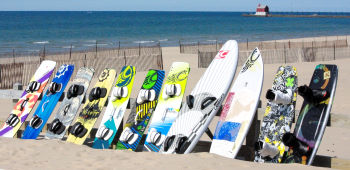Let’s face it, kitesurfing is an expensive hobby, so you want to make sure your kit lasts as long as possible. Although it may seem like a chore at the time, the best way to ensure your kit lasts as long as possible is to maintain and store it properly. We’ve gathered some top tips for kit maintenance from our instructors, to help you get the most out of your equipment. And for those occasions where something goes slightly wrong, we’ve also included some tips on making small repairs. Should you need something more major, we offer an equipment repair service.
KITE
Before
- When setting up your kite, try to avoid DRAGGING IT OVER ROCKS as these will scuff the material
- INSPECT your LINES and CANOPY (especially near the leading edge) before every session
- Only SELF LAUNCH if you are a proficient kiter – getting this wrong can severely damage the kite (or you!)
- If not flying the kite, carry it towards the water in a “U” or SMILEY FACE shape, with the struts facing upwards
- CHECK YOUR BRIDLES before each session
- Before pumping up your kite, CHECK THE BLADDERS ARE NOT TWISTED
- DON’T PUSH THE PUMP TOO FAR INTO THE VALVE, and check there is NO SAND IN THE VALVE
During
- PICK THE RIGHT KITE SIZE – Going out too overpowered can make you more likely to damage the kite
- Try to avoid crashing your kite, but if you can’t help it, RELEASE THE BAR and crash in DEEP WATER
- If you decide to take anything more than a 10-minute break, PACK UP YOUR KITE. Leaving the kite FLAPPING IN THE WIND or LYING IN THE SUN will damage the kite
- Spend the last 10 minutes of your session cruising along gently, this will give the kite time to DRY OUT

After
- Only SELF LAND if you are proficient – slamming your kite into the beach or dragging it over rocks will tear through the canopy
- Pack up your kite as soon as possible, especially in strong winds. A FLAPPY KITE IS AN UNHAPPY KITE.
- If possible, PACK UP YOUR KITE AWAY FROM SAND, on something soft like GRASS
- Lightly BRUSH OFF ANY SAND
- If you’re kiting somewhere particularly HOT with very SALTY WATER (i.e. NOT THE UK) then wash your kite with fresh water after each session to avoid the SALT DAMAGING THE KITE
- Pack your kite away FULLY DRY – if you cannot dry it straightaway, be sure to unpack it and dry it out as soon as possible. KITES LEFT WET WILL GET MOULDY.

Storage
- STORE YOUR KITE DRY, WITH NO SAND ON IT
- DON’T STORE YOUR KITE SOMEWHERE HOT for long periods of time, as the glue on the seams gets damaged
- Store your kite with the BLADDERS DEFLATED and VALVES OPEN so they do not stretch
- If possible, store your kite in it’s KITE BAG, as this is the safest place for it
Repairs
- If your kite requires a MAJOR REPAIR, or if the damage is NEAR THE LEADING EDGE take it to a kite shop to be professionally fixed
- Small rips and scuffs (NO BIGGER THAN 1CM) can be fixed with a PATCH, which are often included with your kite. Make sure to ROUND OFF the corners of the patch and ALWAYS STICK THE PATCH ON THE INSIDE OF THE KITE
- Before applying the patch, CLEAN THE AREA AROUND THE HOLE
- Small PIN HOLES IN A BLADDER can also be fixed with a patch

BAR & LINES
Before
- UNWRAP YOUR LINES CAREFULLY, taking special care to AVOID GETTING SAND IN THE LARKS HEAD KNOTS as this will wear away at the rope material
- If you set up on the sand, DUNK YOUR BAR IN THE SEA to get rid of the sand
After
- FOLD YOUR LINES NEATLY around the bar; this will not only make it quicker to set up on your next session, but also increase their life
- After every session, WASH YOUR BAR AND LINES WITH FRESH WATER
- WASH METAL PARTS WITH FRESH WATER as these are the points that get damaged most by salt
Storage
- Store your bar and lines NEATLY; IN A COOL, DRY PLACE
BOARD
Before
- Every 10 – 15 sessions, CHECK THE SCREWS ON THE HANDLE AND FINS
- If your screws regularly come loose, TRY USING MEDIUM STRENGTH LOCKTITE
After
- After each session, BRUSH THE SAND OFF YOUR BOARD
- WASH EXCESS SALT OFF YOUR FOOTSTRAPS
Storage
- Store your board in a COOL, DRY PLACE

HARNESS
After
- When taking off your harness, LOOSEN THE STRAPS SO THEY DON’T STAY IN THE SAME PLACE, as this reduces them wearing in one point
- WASH your harness and leash in FRESH WATER after every session
- Check thoroughly and REMOVE ANY SAND OR SALT FROM YOUR SAFETY RELEASE
Storage
- Store your harness in a COOL, DRY PLACE


